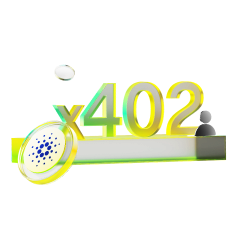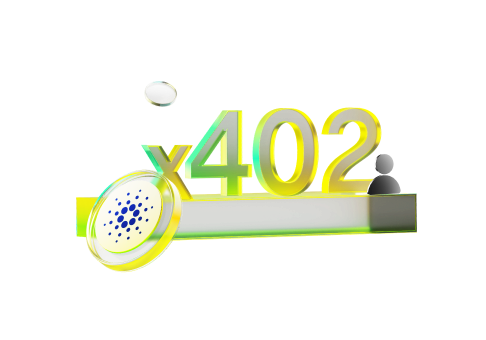What Is the x402 Payment Standard on Cardano
The x402 payment standard marks a fundamental shift in blockchain payments. Cardano (ADA) integrated this protocol in October 2025 to enable AI agents to execute transactions without human oversight. This development positions Cardano at the forefront of the AI Agent Economy.
The protocol uses the HTTP 402 "Payment Required" status code as its foundation. This approach creates a direct path for machines to pay other machines through APIs. The system removes traditional barriers like user registrations, complex authentication, and email verifications. AI agents can now handle payments independently while maintaining security and transparency.
Charles Hoskinson, Cardano's co-founder, called this integration "very big for Cardano." His enthusiasm reflects the strategic importance of capturing the emerging AI economy before competitors establish dominance.
How x402 Works on the Cardano Blockchain
The Masumi Network team implemented x402 with specific features tailored for Cardano. AI agents gained three core capabilities through this integration. First, they can pay for resources and services using API calls. Second, they execute transactions using both ADA and USDM, Cardano's pegged stablecoin. Third, they interact with other AI systems without intermediaries.
The technical implementation goes beyond basic payment processing. The Masumi team added a trust layer with four essential components:
- Identity verification to confirm agent legitimacy
- Reputation tracking for reliable service providers
- Transparent auditing for all transactions
- Refund mechanisms for failed operations
Patrick Tobler from NMKR demonstrated the system's capabilities on Cardano's testnet. His proof-of-concept showed x402 triggering on-chain actions like minting test memecoins. Users pay 2 USDM plus minimal ADA fees to complete transactions. This simple demo proves the protocol works for real blockchain operations.
Cardano's Development Timeline and Major Updates
Cardano's path to x402 integration followed a series of strategic upgrades. Each milestone built the foundation for AI-powered payments.
Chang hard fork
Achieved full decentralization
Plomin hard fork
Enabled on-chain voting
Grayscale files ETF
Institutional validation
Constitutional Committee elected
Community governance established
RWA tokenization focus
Strategic pivot to real assets
Hydra v1.0.0 released
Layer-2 scaling live
x402 integration begins
AI payments enabled
$33 million DeFi funding
Liquidity boost approved
The Chang hard fork stands out as particularly important. It transferred network control to community-elected Delegated Representatives (DReps) and Stake Pool Operators (SPOs). This decentralization prepared Cardano for autonomous AI operations where no central authority controls transactions.
Market Position and Competitive Analysis
Cardano faces significant challenges in the current blockchain landscape. The network holds $36.2 million in stablecoins while Ethereum (ETH) holds $163 billion and Tron holds $79 billion. This gap shows why innovative features like x402 matter for Cardano's future.
The DeFi metrics tell a similar story. Cardano's Total Value Locked (TVL) sits at $290.4 million. The market cap reached $36.2 billion in October 2025. These numbers show steady growth but lag behind major competitors. The x402 integration offers a path to differentiation through AI specialization rather than competing directly in traditional DeFi.
Institutional interest grows despite market challenges. Cardano ETF filing in February 2025 signals confidence in Cardano's long-term prospects. The fully decentralized governance structure appeals to institutions worried about regulatory compliance.
Charles Hoskinson believes x402 positions Cardano to outpace Ethereum and Solana in the AI sector. His vision extends beyond simple payments. The protocol enables full automation of DeFi operations including token swaps, lending, and staking. Users set parameters and AI agents handle execution. This approach reduces complexity for everyday users while maintaining decentralization.
Technical Architecture Behind x402 Implementation
The x402 standard originated at Coinbase before expanding across the web ecosystem. Google now recognizes it as part of their Agent-Payment Protocol (AP2). This mainstream adoption validates Cardano's implementation strategy.
The HTTP 402 status code existed for decades without practical use. Blockchain technology and AI agents finally created the right conditions for implementation. The protocol revives the original internet dream of frictionless micropayments. Machines can now transact as easily as they exchange data.
The Masumi Network's implementation focuses on practical functionality. Smart contract integration remains a priority. Early tests show promise for automating complex DeFi operations. The team continues refining the protocol through public demos and testnet experiments. Each iteration improves reliability and expands capabilities.
Funding and Financial Infrastructure
Cardano's community approved substantial funding to support the x402 ecosystem. The October 2025 allocation of $33 million in ADA specifically targets stablecoin liquidity for DeFi projects. This injection addresses a critical weakness in Cardano's current infrastructure.
The broader funding picture shows ambitious plans:
- 350 million ADA allocated for 2025 ecosystem funding
- 2 million ADA committed to Cardano Venture Hub in 2026
- 12% marketing budget increase planned for 2026
Past spending faced criticism from Hoskinson himself. The Cardano Foundation spent $15 million on marketing in 2024, including an FC Barcelona sponsorship. Yet DeFi adoption remained slow. The x402 integration represents a more targeted approach. Instead of broad marketing, Cardano focuses on capturing a specific emerging market.
Future Roadmap and Strategic Initiatives
Cardano's roadmap extends well beyond x402. The network plans to implement CIP-0113 and CIP-0143 standards next. These improvements enhance smart contract capabilities and cross-chain communication. Both upgrades support the broader AI payment ecosystem.
The Midnight project deserves special attention. This privacy-focused sidechain targets institutional investors who need programmable privacy. Banks and corporations require confidential transactions for regulatory compliance. Midnight provides this capability while maintaining blockchain transparency where appropriate.
Project Hydra continues development after the v1.0.0 release. The Layer-2 solution promises thousands of transactions per second. Combined with x402, Hydra enables massive AI agent networks. Millions of agents could transact simultaneously without congesting the main chain. This scalability becomes essential as AI adoption accelerates.
Real-world asset tokenization emerged as another strategic focus. The Foundation sees RWAs as crucial for mainstream adoption. Traditional assets like real estate, commodities, and securities can integrate with AI payment systems. This combination creates new financial products impossible with conventional technology.
Review ADA Price on LBank
ADA() Price
The current price of
ADA Price Analysis and Market Sentiment
ADA trades within a descending channel between $0.58 and $0.75 as of October 2025. The current price hovers near $0.6403, showing consolidation at mid-range levels. Technical indicators provide mixed signals about short-term direction.
The Relative Strength Index (RSI) stands at 43.5, indicating mild bearish pressure. The Chaikin Money Flow (CMF) remains neutral at 0.06. These metrics suggest uncertainty rather than strong directional momentum. Breaking above $0.75 opens the path to $0.85. Falling below $0.58 risks a decline to $0.54.
Long-term projections remain optimistic despite current price action. Hoskinson predicts over 10 million active users by 2030. This growth depends on successful execution of the current roadmap. The x402 integration represents one piece of this larger puzzle. Scaling solutions, privacy features, and real-world adoption must align for this vision to materialize.
Practical Applications for Developers and Users
The x402 standard changes how developers approach Cardano applications. They can now build services where AI agents handle all payment logic. This opens new categories of applications previously impossible or impractical.
Consider these emerging use cases:
- Automated trading bots that pay for market data in real-time
- Content generation services that charge per API call
- Data analysis tools that purchase computing resources dynamically
- Supply chain systems where IoT devices transact autonomously
Regular users benefit even without understanding technical details. DeFi becomes accessible when AI agents manage complexity. A user might say "invest $1000 in yield farming" and the agent handles everything. The agent finds optimal pools, executes swaps, stakes tokens, and manages positions. All transactions remain transparent and auditable through the blockchain.
The trust layer protections ensure user safety. Reputation systems identify reliable agents over time. Audit trails provide complete transaction history. Refund mechanisms protect against service failures. These features build confidence in autonomous systems.
The Path Forward for Cardano's AI Economy
The x402 integration positions Cardano uniquely in the blockchain space. While competitors focus on traditional DeFi and NFTs, Cardano targets the AI economy. This strategic differentiation could prove decisive as AI adoption accelerates globally.
Success depends on ecosystem development. Cardano needs developers building AI applications. It needs businesses adopting automated payment systems. Most importantly, it needs real-world use cases that demonstrate value. The proof-of-concept shows technical feasibility. Now comes the harder task of market adoption.
The combination of x402, Hydra scaling, Midnight privacy, and RWA tokenization creates a comprehensive platform. Each component supports the others. AI agents need fast transactions from Hydra. Institutions need privacy from Midnight. Real assets need tokenization infrastructure. Together, these features position Cardano as infrastructure for the next generation of financial services.

